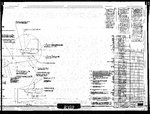drgondog
Major
Finally - here is the Top P-51D Fuselage Installation drawing in which the 109-25001 rolls up to. It shows the P-51D-5 as the original view of the 'no DFF' production run. Around the base of the vert fin is drawn a View A, referenced below, to insert the 109-25001 DFF Assembly by name and Effectivity note [3]. Look closely at the Fin and note that it seems straight for about 1/2 of its leading edge, in contrast to the line shown on the 109-25001-1 part.
Effectivity Note [3.] found in Zone 1 of 106-31001 for the fuselage assembly of fins, doors, fillets, etc, reads as follows:
[3.] USED ON SHIPS NA109 (1001 SUBS)AAF 44-14253 SUBS AND NAA 111 (401 SUBS) AAF 44-11153 SUBS
There are no other DFF Assembly drawings for the P-51D, only for the P-51H. There is no other next Assembly for the 25001-1 Fin Assy other than the 106-31001 Installation Fuselage cover.
You may correctly assume that all swayback, slightly curved, nearly straight and straight 109-25001-3 Fins are what NAA intended to put on the P-51D series after 44-14252.
Effectivity Note [3.] found in Zone 1 of 106-31001 for the fuselage assembly of fins, doors, fillets, etc, reads as follows:
[3.] USED ON SHIPS NA109 (1001 SUBS)AAF 44-14253 SUBS AND NAA 111 (401 SUBS) AAF 44-11153 SUBS
There are no other DFF Assembly drawings for the P-51D, only for the P-51H. There is no other next Assembly for the 25001-1 Fin Assy other than the 106-31001 Installation Fuselage cover.
You may correctly assume that all swayback, slightly curved, nearly straight and straight 109-25001-3 Fins are what NAA intended to put on the P-51D series after 44-14252.
Attachments
Last edited:

